You’re reclined back on a couch, while the therapist sits in a nearby chair with a notepad and pen in hand. They are watching your every move, jotting things down, probing into your upbringing and childhood traumas one question at a time. “And how does that make you feel?” they enquire.
For a lot of people, this is the image that springs to mind at the mention of the word therapy. Without getting therapy ourselves, movies and TV shows are often our only references, and they don’t always do the best job of illustrating the process and relationships involved.
Even after hours of detailed lectures and theory work at the University of Sydney, psychology professor and therapist Gillian Straker found that her students still had questions about what actually went on behind the closed door.
Alongside highly experienced psychologist Jacqui Winship, the pair put their heads together and began working on a book to shed some light on how the process really works, why it works, and debunking common misconceptions.

Over nine inspiring stories of real-life client transformations, The Talking Cure highlights our shared humanity, shared struggles, and the life-changing power of the therapy relationship.
“It really started when I was at Sydney University in the middle of giving a course on relational therapy to a group of students,” Gill recounts.
“They kept saying to me, ‘We understand the principles and we kind of get it, but what does it actually look like?’ I thought, ‘How can I give people a peek behind the consulting room door to actually see how it plays out?'”
“We are hoping to demystify and destigmatise psychotherapy, to help people understand what it’s about and perhaps encourage people to give it a try,” says Jacqui.
Another big focus of the book was to break down the widely held idea of ‘us and them’ – that there is a clear distinction between therapists and patients, or between people who have got it all together and people who are damaged or flawed.
“We all have issues of differing types and intensities,” Jacqui points out.
“All of us are vulnerable and flawed and struggle with what it is to be human. In fact, many of our clients are very high functioning in a lot of aspects of their lives and might be lawyers or doctors, yet they still have things that trouble them internally and play out for them in their heads and relationships.”
If you were to mention that you were getting therapy to family members, friends or colleagues, do you think it might raise a few eyebrows?
This stigma is something they are determined to shift. “Some people think that therapy is only for the disturbed and people who have got major issues,” Gill laughs.
“It’s really not. It’s for anybody. I also want to do away with the common misconception that you’re weak if you seek help, that it means you haven’t been able to sort out your own problems.”
Jacqui adds, “People also tend to think that if they go to therapy, they’re admitting that there’s something terribly wrong with them and they don’t want to acknowledge that. Other people feel like there’s a stigma attached to going to therapy, that others are then going to see them as weird or mad.”
Many clients seek therapy as a result of an external or internal crisis, yet it is also very common for people to come without an explicit issue to talk about.
“We have many people who come just because of a general sense of dissatisfaction, a feeling that they haven’t found what makes them happy, that they are not achieving their true potential, or simply would like to understand themselves better. They don’t necessarily have a specific issue that’s playing out in a bad way, but they see the value in being able to grow an understanding of themselves,” she says.
What to expect in therapy
Jacqui laughs when I ask what to expect and mention the Freudian scenario of the patient lying on the couch.
“I do actually have a couch in my room, but most people don’t sit on it! For most people, I would welcome them into the room and invite them to take a seat. They can choose out of two chairs or a couch, wherever they are most comfortable sitting. Then I would try to put them at ease and invite them to tell me a little bit about what brought them to me and how they are feeling about being there.”
For both Jacqui and Gill, the first session is very much about getting to know the person and the presenting problem, giving them space to talk, explaining the process and answering any questions.
Subsequent sessions delve deeper into the person’s life story, in order to understand their history and contextualise their current situation, before forming ideas of what to do.

“I think there’s a misconception that the therapist will provide the solution, rather than empower you and help you to find the blocks to your own agency and your own fulfilment and help you to mobilise,” Gill says, and Jacqui agrees.
“Many people think that the therapist will have all the answers, that the therapist will do something that will make it better. It’s sometimes a bit of a shock to realise that therapy is a process in which you make your own gains with the help of the therapist, but they don’t have a magic wand to make all your problems go away. I wish I did sometimes, but I don’t,” she laughs.
So if we have to do a lot of the work ourselves, what does therapy offer that we can’t do on our own?
Gill uses the metaphor of a child doing a puzzle to illustrate the power of the therapy relationship.
“You’ve got all the pieces there, but you can’t see how they fit together. If a parent comes over and does it for you, you’re disempowered, but if they nudge a piece of the puzzle closer to your hand, you might suddenly see where it fits and be able to fit it in yourself.
“I think it’s an illusion to think that we can sort out everything ourselves. Research has shown quite clearly that if you have two or three minds thinking together about how to solve a problem, you’re going to solve that problem quicker than if you had each of those individual minds working in silos and not communicating.”
Living in a culture that applauds self-sufficiency and independence, it can feel uncomfortable to reach out to someone for help, yet both authors are firm on their position that humans are naturally much better at figuring things out in the context of a relationship, where we are able to get feedback and learn about ourselves by being reflected by another person.

“We all have blind spots and we can’t see our own blind spots by very definition. We often don’t like having them pointed out by partners or friends either, but in therapy it’s a special kind of relationship where the therapist can gently and empathically point out your blind spots and take them more seriously, and we can’t do that for ourselves,” Jacqui explains.
“The therapist is able to make sense of it and see it from the outside in a way that is perhaps different to how your friends or your partner might respond to you. You get somebody who is there to listen to you and who is making a strong attempt to understand you from the inside and what is going on for you internally, but who is also able to reflect back to you what they are hearing with the added understanding that a therapist might make.”
From birth, our brains are constantly trying to organise our experiences into patterns to help us understand who people are and how the world works.
As Gill explains, “our inner experience organises our external perception. When we believe what we want to believe, rather than what is necessarily true, we start filtering out information.”
The process of therapy helps to expose any errors in our perception and see the world with much clearer eyes.
“It’s not a miracle cure and it is hard work, which a lot of people don’t realise. You have to identify what you’re doing, and then you have to do the work and practise it outside of therapy. It’s not just what happens in the room.”
Both women have been in therapy themselves, and know how difficult it can be on the other side of the couch, so to speak.
Why is therapy so challenging?
“Therapy is a challenging process,” Jacqui admits.
“It’s taking you out of your comfort zone and encouraging you either to accept things that you might not want to accept, or change things that might be difficult to change.”
Ultimately though, the process is about enriching the life of the client.
It is about helping the person manage their issues better, transform how they work, love and play, and leave with improved confidence, happiness and relationships.
For this reason, they also hope The Talking Cure will encourage people to see psychotherapy as something nourishing for general wellbeing, not just a treatment.

The book itself is broken into nine real-life client stories, each exploring a common issue – topics such as difficult children, being painfully shy, or being attracted to controlling partners – with guidance and tips.
“In most books, there’s a sort of disclaimer at the beginning that says if you recognise yourself in this story, it’s coincidental, but we would say that if you don’t recognise yourself in any of these stories, then we have failed in what we have tried to write. We have tried to write about all of you,” Jacqui says.
“Alfred Adler said that the only normal people are those you don’t know very well,” she laughs.
“When you really get to know and talk to people, you realise that even though on the outside it might look as if their life is perfect, on the inside it often doesn’t feel that way for them. You realise that we all have our areas of strength, but we also all have our areas of difficulty.”
Gill agrees and points out, “We spend a lot of money going overseas and doing external journeys, but I promise you, the internal journey is very interesting.”

.jpg)

